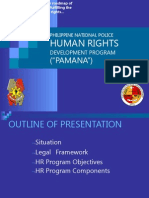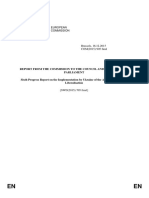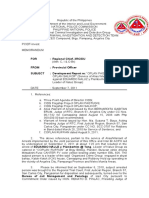Executive Summary
Executive Summary
Uploaded by
Susan Trillanes Rabano-JallaCopyright:
Available Formats
Executive Summary
Executive Summary
Uploaded by
Susan Trillanes Rabano-JallaCopyright
Available Formats
Share this document
Did you find this document useful?
Is this content inappropriate?
Copyright:
Available Formats
Executive Summary
Executive Summary
Uploaded by
Susan Trillanes Rabano-JallaCopyright:
Available Formats
EXECUTIVE SUMMARY The Philippines is a source, transit and destination country for human trafficking.
US Secretary of State Hillary Clinton cited in her agencys 2009 global report on trafficking that the Philippines is now in Tier 2 watch list where the government of the country was not able to show tangible results in convicting traffickers and to make
progress towards compliance of the minimum standards for the elimination of trafficking. Human trafficking is a violation of human rights where women and children are exploited through prostitution, pornography, sexual exploitation, forced labor, slavery, involuntary servitude or debt bondage, and removal or sale of organs. The enforcement of the Anti-Trafficking Act of 2003 or RA 9208 is lackluster and the low conviction rate has not deterred the crime of trafficking from flourishing. The political, socio-cultural, economic and other personal factors fuelled by corruption in the bureaucracy have increased the incidence of trafficking which is often not reported by the willing victims. The Department of Justice (DOJ) as the Secretariat of the Inter
Agency Council Against Trafficking (IACAT) was not able to effectively establish proper documentation, monitoring and evaluation to prevent the delays in prosecution as manifested by the large number of cases pending preliminary investigation. The Philippine National Police (PNP) is the primary law enforcement agency tasked to undertake surveillance, investigation and arrest of individuals or persons suspected to be engaged in trafficking and to formulate plans and programs for the prevention and/or reduction of trafficking. Human Trafficking or the enforcement of RA 9208 is one of the mandates that falls under the PNP Women and Children Protection Desks (WCPD) formerly womens desks in all police stations nationwide. However, crime prevention and law enforcement do not rest entirely upon the police force to address especially the
human trafficking cases, a concern that needs a holistic approach and cooperation of a majority of stakeholders based on its peculiar nature. The strengthening of WCPD is a challenge that the PNP leadership needs to immediately address. The women and specially the children who are victims and those who are in danger of victimization from human trafficking should be given priority attention to protect their human rights. The response of the PNP as the primary law enforcement agency in Anti-Trafficking in Persons Act of 2003 (RA 9208) is crucial to eliminate or reduce the incidence of trafficking in persons through prevention, arrest and prosecution of offenders and to provide mechanisms for the victims to access government and non-governmental interventions for their protection and rehabilitation. However, there is a conflict between the mandate and the strategy in addressing the trafficking cases. The focus is placed on WCPC/WCPD for its implementation when there is a need for concerted efforts from all operational units of the PNP (NSUs and
RMGs/PMGs) and not only police stations should be involved in implementing the law on trafficking. The Quad concept of operations (intelligence, operations, investigation and police community relations) are not being fully utilized. The compartmentalization of trafficking as women and children issues has hindered effective law enforcement. The SWOT Analysis, Gap Analysis and Strategy Map using the Balanced Scorecard perspectives were used for the triangulation on the needed strategic interventions to strengthen WCPD for effective law enforcement response in human trafficking cases. Weaknesses-Opportunities (W-O) Strategic Option optimizing
opportunities while neutralizing weaknesses provided the following strategies: 1) Quad (police community relations, intelligence, operations, investigation) focused TIP
operations; 2) WCPD Expansion (NSUs and operating units); 3) Case documentation and monitoring (though Anti-Trafficking Section); 4) Systems Innovation (Case management and Database/Databank); 5) Improved GAD funds utilization; 6) Enhanced framework for cooperation, (Creation of Task forces and MOA with NGOs involved in TIP); and 7) Performance and Policy review.
The WCPD balanced scorecard was created to measure specific performance. The strategy map with the key objectives and the balanced scorecard with its measures and targets as well as the action plan with initiatives and budget will show and ensure the effective management and implementation of the strategic option/strategic interventions which were identified in the SWOT analysis and gap analysis. The mandated 5% GAD funds of the total PNP budget to be utilized for women and children concerns to include TIP programs and the strong support of international and local organizations particularly the LGU Peace and Order funds will assure resource mobilization and implementation.
The Directorate for Investigation and Detective Management (DIDM) shall be the office primarily responsible for the implementation of the initiatives and coordination of efforts of tasked units. The Chief, PNP through DIDM shall issue the Letter of Instruction (LOI) on Strengthening the Women and Children Protection Desks in Combating
Human Trafficking which will incorporate an integrated approach in combating trafficking, expansion of WCPD, systems innovation, and for PROs, NSUs, and other police units to incorporate the strategies in their plans and programs including the crime prevention and law enforcement component in the LGU Integrated Area Community Public Safety Plan (IA/CPSP). The implementation plans and detailed programs shall be formulated from the local level in different WCPDs to be consolidated at WCPC for the component of
IA/CPCP. The focus on TIP would be made a component of the model police stations on strengthening WCPD nationwide.
A Memorandum/Directive from the C, PNP to all police units working on human trafficking shall also be issued for the forging of MOA with NGOs involved in the prevention, of trafficking and the protection and rehabilitation of victims and also the creation of Task Forces in Anti-Trafficking in local level to be spearheaded by the Local Chief Executives through the Peace and Order Councils (POCs).
A strengthened WCPD with the implementation of proposed strategies is expected to remove the Philippines from the Tier 2 watch list with its improved performance on combating human trafficking. The LGU focused approach in anti-trafficking as part of its crime prevention, law enforcement and social development programs would address the concerns of effective prevention of trafficking, prosecution and conviction of traffickers and protection/rehabilitation/reintegration of victims with the expected impact of reducing incidence of trafficking. The POCs and Development Councils of the LGUs of which the PNP and DILG are members are expected to incorporate the recommended strategies as part of the IA/CPSP and Development Plans to address the strengthening of the WCPD in the local level in the fight against human trafficking. Batangas City was exemplified as pilot area to show how the strategy will be implemented at the local level focused on LGU/POC formulated IACPSP addressing prevention of trafficking, prosecution of traffickers and protection of victims and potential victims and their rehabilitation and reintegration in the community.
You might also like
- Effectiveness of Crime Prevention StrategiesDocument29 pagesEffectiveness of Crime Prevention StrategiesOdigirb Galapia Gumarang II87% (55)
- Thesis Criminology 2Document47 pagesThesis Criminology 2jvb_buena273475% (51)
- PNP Human RightsDocument32 pagesPNP Human Rightscrimelove100% (1)
- Anti Corruption Manual 2007Document116 pagesAnti Corruption Manual 2007Cristina Joy Vicente Cruz83% (6)
- Six Master Plans of Law EnforcementDocument28 pagesSix Master Plans of Law EnforcementDanny Boy CalzadaNo ratings yet
- A Study On The Effectiveness of Patrol Deployment in The Maintenance of Peace and Order in San Juan Batangas V.2Document53 pagesA Study On The Effectiveness of Patrol Deployment in The Maintenance of Peace and Order in San Juan Batangas V.2lhyka nogales100% (2)
- Gabitanan and Daguman ThesisDocument54 pagesGabitanan and Daguman ThesisLee Sta Ana50% (2)
- UntitledDocument85 pagesUntitledLyka LomaNo ratings yet
- PNP MasterplansDocument117 pagesPNP MasterplansPat Dela CruzNo ratings yet
- R e S T R I C T e DDocument8 pagesR e S T R I C T e Dgilbertmendova3No ratings yet
- SandiganDocument194 pagesSandiganPSS PRO12No ratings yet
- Singapore NRA ReportDocument94 pagesSingapore NRA ReportcheejustinNo ratings yet
- Op Plan Human TraffickingDocument6 pagesOp Plan Human Traffickingstanleymudzamiri8No ratings yet
- Law Enforcement Operations and Planning With Crime Mapping Unit 1Document21 pagesLaw Enforcement Operations and Planning With Crime Mapping Unit 1dominiqueNo ratings yet
- Terrorism and Transnational CrimeDocument38 pagesTerrorism and Transnational CrimeJayson GeronaNo ratings yet
- Oplan LambatDocument3 pagesOplan LambatferosiacNo ratings yet
- Fraud: From National Strategies To Practice On The Ground-A Regional Case StudyDocument11 pagesFraud: From National Strategies To Practice On The Ground-A Regional Case Studyfriska13No ratings yet
- FernandezDocument6 pagesFernandezMa. Gemille NopradaNo ratings yet
- CCPCJ BDocument7 pagesCCPCJ BCristobal Colon Model United Nations100% (1)
- 5 - Sanitized - NRA - Full - VersionDocument25 pages5 - Sanitized - NRA - Full - VersionSinra 2017100% (1)
- UK Home Office: Nottinghamshire FinalDocument28 pagesUK Home Office: Nottinghamshire FinalUK_HomeOfficeNo ratings yet
- Final Draft of NRM For VietnamDocument38 pagesFinal Draft of NRM For VietnamJustitia Avila VedaNo ratings yet
- IC 029 Transnational Crime and The Philippine Case (Mr. Daniel Z. Bernardo) PDFDocument14 pagesIC 029 Transnational Crime and The Philippine Case (Mr. Daniel Z. Bernardo) PDFDhen IsmNo ratings yet
- The Correct™ Movement Website PDF File: Graft and Corruption: The Philippine ExperienceDocument11 pagesThe Correct™ Movement Website PDF File: Graft and Corruption: The Philippine ExperiencePatrick UyNo ratings yet
- Icct Colleges Foundation IncDocument6 pagesIcct Colleges Foundation IncLEX ANN MAY SERAFICONo ratings yet
- Research Brief Multiple Systems Estimation For Estimating The Number of Victims of Human Trafficking Across The WorldDocument46 pagesResearch Brief Multiple Systems Estimation For Estimating The Number of Victims of Human Trafficking Across The WorldVinciNo ratings yet
- Final ManuscriptDocument54 pagesFinal ManuscriptRalph CelesteNo ratings yet
- The Correct™ Movement Website PDF File: Graft and Corruption: The Philippine ExperienceDocument13 pagesThe Correct™ Movement Website PDF File: Graft and Corruption: The Philippine ExperiencePatrick UyNo ratings yet
- 80 INTERPOL General Assembly: Remarks by Lieutenant General Pham Quy Ngo Vice Minister of Public SecurityDocument4 pages80 INTERPOL General Assembly: Remarks by Lieutenant General Pham Quy Ngo Vice Minister of Public SecurityMaja MaricNo ratings yet
- Fiji Money Laundering and Financing of Terrorism National Risk Assessment - National Anti-Money Laundering Council - Finance Intelligence Unit RBFDocument5 pagesFiji Money Laundering and Financing of Terrorism National Risk Assessment - National Anti-Money Laundering Council - Finance Intelligence Unit RBFSeni NabouNo ratings yet
- Santiago HRDocument32 pagesSantiago HRRay MacoteNo ratings yet
- Leps 550 Final PaperDocument12 pagesLeps 550 Final Paperapi-525082247No ratings yet
- An Intervention Management Operational Plan To Address Extra Judicial KillingDocument20 pagesAn Intervention Management Operational Plan To Address Extra Judicial KillingHyman Jay BlancoNo ratings yet
- MODERATED CAUCUS TOPIC - RepliesDocument2 pagesMODERATED CAUCUS TOPIC - RepliesArsh MathurNo ratings yet
- AMSF - Detecting Financial Flows of Modern Slavery and Human Trafficking A Guide To Automated Transaction Monitoring - 2023 - VGBDocument32 pagesAMSF - Detecting Financial Flows of Modern Slavery and Human Trafficking A Guide To Automated Transaction Monitoring - 2023 - VGBnourtabib692No ratings yet
- Action Plan or Strategies in Combating Human Trafficking and CorruptionDocument3 pagesAction Plan or Strategies in Combating Human Trafficking and CorruptionAl-juffrey Luis AmilhamjaNo ratings yet
- Police CompetencyDocument10 pagesPolice CompetencyJushua PatulotNo ratings yet
- Revised Penal Code Title II and VIIDocument7 pagesRevised Penal Code Title II and VIIStriker StrikerbaseNo ratings yet
- Ass 11Document4 pagesAss 11Angelika PinedaNo ratings yet
- Strategic Policing Requirement V1.3Document80 pagesStrategic Policing Requirement V1.3Charity AgbajiNo ratings yet
- Local LiteratureDocument12 pagesLocal LiteratureKen Mitchell Morales100% (1)
- VKDocument13 pagesVKLealynEspenidaNo ratings yet
- GROUP 11 FINAL-THESIS-Challenges-in-the-Conduct-of-Police-Investigation-in-Zambales-PPO As of JANUARY 21 2023Document41 pagesGROUP 11 FINAL-THESIS-Challenges-in-the-Conduct-of-Police-Investigation-in-Zambales-PPO As of JANUARY 21 2023Mhar GinezNo ratings yet
- GPM 205 Group 3Document10 pagesGPM 205 Group 3Tapiwanashe Makanaka MadzivaidzeNo ratings yet
- Crimeprevention ColonDocument60 pagesCrimeprevention ColonJohn Lester SuarezNo ratings yet
- Review of Anti-Corruption Strategies: Rob MccuskerDocument82 pagesReview of Anti-Corruption Strategies: Rob MccuskerMohammed Shafi Ahmed100% (2)
- Ramos Analisynthesis 1Document3 pagesRamos Analisynthesis 1Hanns ReadsNo ratings yet
- UK Home Office: LincolnshireDocument36 pagesUK Home Office: LincolnshireUK_HomeOfficeNo ratings yet
- CSCAP Memo No. 11 - Human TraffickingDocument3 pagesCSCAP Memo No. 11 - Human TraffickingHanyung WuNo ratings yet
- Laundering The Proceeds of CorruptionDocument54 pagesLaundering The Proceeds of CorruptionouestlechatdememeNo ratings yet
- Nicholo ManuscriptDocument50 pagesNicholo ManuscriptRalph CelesteNo ratings yet
- The Role of Local Government in Crime Prevention in South AfricaDocument8 pagesThe Role of Local Government in Crime Prevention in South Africabatiya urbanusNo ratings yet
- Counter Terrorism Policy PaperDocument27 pagesCounter Terrorism Policy PaperShiela Medrano100% (1)
- Thesis January 2019 New FormatDocument17 pagesThesis January 2019 New FormatHarold KinatagcanNo ratings yet
- United Nations Office On Drugs and Crime Human Trafficking: Trafficking/what-Is-Human-Trafficking - Html?ref MenusideDocument10 pagesUnited Nations Office On Drugs and Crime Human Trafficking: Trafficking/what-Is-Human-Trafficking - Html?ref MenusideErvin Ralph S. VenusNo ratings yet
- The Problem and Its SettingDocument35 pagesThe Problem and Its Settingshanti dimaanoNo ratings yet
- Business Law Assignment - FinalDraftDocument6 pagesBusiness Law Assignment - FinalDraftJaphet MarkNo ratings yet
- Police Patrol and Communications: By: Pssupt Napoleon B Pascua (Ret)Document17 pagesPolice Patrol and Communications: By: Pssupt Napoleon B Pascua (Ret)Hercules Olaño100% (1)
- About Human TraffickingDocument6 pagesAbout Human TraffickingWorld Vision ResourcesNo ratings yet
- EC Report UkraineDocument12 pagesEC Report UkraineJames LynchNo ratings yet
- PHMI Essentials 2022 - Corporate - TEST - Salvador Gonzalez - Payroll CoordinatorDocument25 pagesPHMI Essentials 2022 - Corporate - TEST - Salvador Gonzalez - Payroll CoordinatorSalvador GonzalezNo ratings yet
- Oral and Dental Aspects of Child Abuse and Neglect: Review Group Latest RevisionDocument7 pagesOral and Dental Aspects of Child Abuse and Neglect: Review Group Latest Revisionmanuela de vera nietoNo ratings yet
- Dinesh Jangid Final FileDocument84 pagesDinesh Jangid Final Filemanojnimesh2630No ratings yet
- Human Trafficking EssayDocument10 pagesHuman Trafficking EssayMeghri AshekianNo ratings yet
- Problemas y Dilemas Éticos en La Investigación de La Explotación Sexual Comercial de Niñas y NiñosDocument6 pagesProblemas y Dilemas Éticos en La Investigación de La Explotación Sexual Comercial de Niñas y NiñosxcvizosoNo ratings yet
- Speical Number of Social Work Review, Vol. 51, No. 1, January To December, 2015Document360 pagesSpeical Number of Social Work Review, Vol. 51, No. 1, January To December, 2015Vibhuti PatelNo ratings yet
- The Devadasis Dance Community of South India A LegDocument39 pagesThe Devadasis Dance Community of South India A LegBidisha SenGuptaNo ratings yet
- Roles of Teachers and LearnersDocument19 pagesRoles of Teachers and LearnersAmit BhardwajNo ratings yet
- Republic Act 10364 JC ReportDocument27 pagesRepublic Act 10364 JC Reportjoshua bagtasNo ratings yet
- Violence Against Women and Role of MediaDocument7 pagesViolence Against Women and Role of MediaDorina NigaiNo ratings yet
- Global Report On Trafficking in Persons 2020Document176 pagesGlobal Report On Trafficking in Persons 2020catolicoNo ratings yet
- Turkmenistan: Recent Developments and U.S. Interests: Jim NicholDocument17 pagesTurkmenistan: Recent Developments and U.S. Interests: Jim NicholSahil SahniNo ratings yet
- Sources of Labor Laws: 1. Labor Standards 2. Labor Relations 3. Social LegislationDocument8 pagesSources of Labor Laws: 1. Labor Standards 2. Labor Relations 3. Social Legislationmegzycutes3871100% (1)
- Baghbhairab Secondary School 2nd Term 2078Document17 pagesBaghbhairab Secondary School 2nd Term 2078krishnaNo ratings yet
- Comparative Police System - BookDocument70 pagesComparative Police System - BookJovie Masongsong100% (2)
- Child Abuse LawDocument3 pagesChild Abuse LawbaimonaNo ratings yet
- (Routledge Research in Gender and Society, 75) Esther Hertzog, Erella Shadmi - Prostitution, Pornography and Trafficking in Women - Israel's Blood Money-Routledge (2019)Document224 pages(Routledge Research in Gender and Society, 75) Esther Hertzog, Erella Shadmi - Prostitution, Pornography and Trafficking in Women - Israel's Blood Money-Routledge (2019)EvanEftNo ratings yet
- 13 SrilankaDocument18 pages13 Srilankayashinthagihan22No ratings yet
- BONDED CHILD LABOUR - A Curse To Indian SocietyDocument13 pagesBONDED CHILD LABOUR - A Curse To Indian Societyleela naga janaki rajitha attiliNo ratings yet
- Chapter 5 (Deviant and Normal Sexuality) Lecture OutlineDocument14 pagesChapter 5 (Deviant and Normal Sexuality) Lecture Outlinedeep81204No ratings yet
- Dragon Tales: Remembering Phi Quang HuyDocument4 pagesDragon Tales: Remembering Phi Quang HuyBlue Dragon Children's FoundationNo ratings yet
- FOR: Regional Chief, 3RCIDUDocument10 pagesFOR: Regional Chief, 3RCIDUConcepcion MpsNo ratings yet
- Child Trafficking A Socio-Legal PerspectiveDocument9 pagesChild Trafficking A Socio-Legal Perspectiveqaziammar4No ratings yet
- Human Trafficking PresentationDocument12 pagesHuman Trafficking Presentationapi-400181138No ratings yet
- Complan RationaleDocument66 pagesComplan Rationaleapi-3750482No ratings yet
- Version of The ProsecutionDocument6 pagesVersion of The ProsecutionAnonymous ubixYANo ratings yet
- Johns ArrestedDocument3 pagesJohns ArrestedNuchems_BlogNo ratings yet
- Criminal Law Case DigestsDocument11 pagesCriminal Law Case DigestsEdeline Cosicol50% (2)

























































































